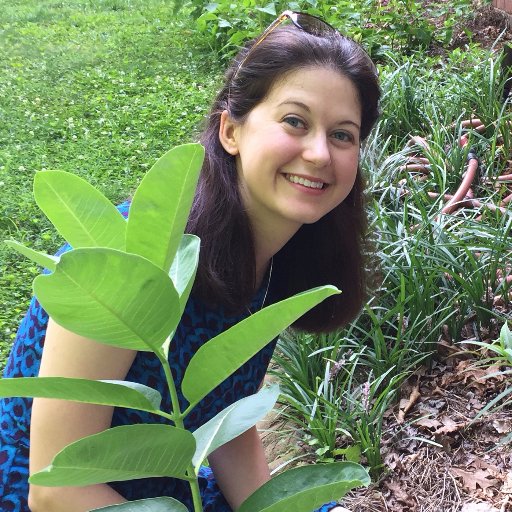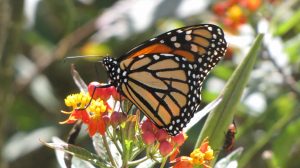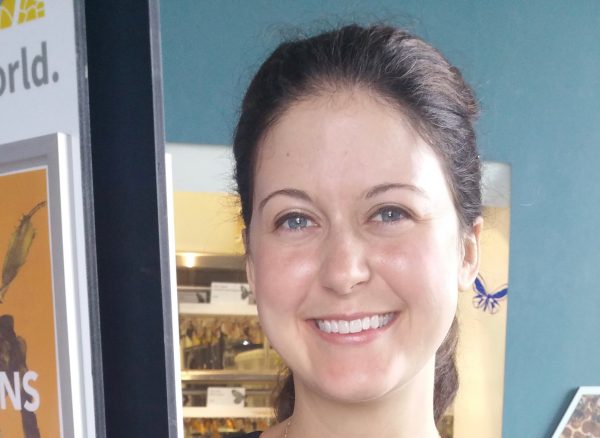Monarch butterfly expert and and AAAS Science and Technology Policy Fellow Dara Satterfield will visit San Antonio this fall for the 2019 Monarch Butterfly and Pollinator Festival. Satterfield, an authority on insect ecology and migration, will lead a workshop on monarch butterfly disease, sit on a panel discussion of how climate change effects migration and immigration, and teach a class at Trinity University as a visiting scholar.

Monarch butterfly disease and migration expert Dara Satterfield will join us in San Antonio for the 2019 Monarch Butterfly and Pollinator Festival. Courtesy photo
Satterfield has visited San Antonio before. Back in 2013, she was one of the first scientists to study “the milkweed patch,” an urban monarch butterfly garden along the Museum Reach stretch of the San Antonio River comprised entirely of Tropical milkweed. That visit resulted in a series of studies that have made Tropical milkweed, Asclepias curassavica, the subject of much debate and sometimes contention.
Along with others that followed, Satterfield’s study suggested that the rigorous growth and heartiness of Asclepias curassavica, technically not native to he U.S., could negatively effect monarchs’ health and migration. Because of Tropical milkweed’s continuous availability–and its wide commercial availability, unlike native milkweeds–the plant can encourage monarchs to break their migration and breed locally. Continued egg laying on plants can also cause a build-up of a nasty monarch-centric disease, known as Ophryocystis elektroscirrha, or OE for short.

Monarchs love Tropical milkweed, Asclepias curassavica, but the plant is somewhat controversial since it is technically a nonnative yet widely availalbe. Photo by Monika Maeckle
Satterfield works with the citizen science initiative Monarch Health, which tracks the prevalence of OE. Through this project, volunteers test for parasites in monarchs and help track the spread of the parasite across North America. The program couples citizens and scientists to increase understanding of host-parasite interactions in monarchs and enhance understanding of monarch biology and conservation.
Following an undergraduate degree in biology from Agnes Scott College, Satterfield earned her Ph.D in Ecology from the University of Georgia. She currently serves as a AAAS Science and Technology Policy Fellow, focusing on international wildlife conservation.
“I have been struck in recent years by the literal links between animal migration and humans,” Satterfield said via email recently, adding that human and animal long-distance movements share similar drivers.
“Essentially, animals move to escape poor conditions or to pursue advantageous habitats for survival and reproduction…I think we can identify with these difficult animal migrations. We as humans understand on a fundamental level the idea of obstacles in a path that is still worth traveling,” she said.
Satterfield will bring her broad understanding of the monarch butterfly migration to the Pearl Stable on October 18 for our forum, Butterflies without Borders: migration and immigration in our changing climate. She joins fellow panelists John Burnett, border correspondent for National Public Radio and Rodrigo Medellín, the “Bat Man of Mexico” on a timely panel discussion that will explore the intersections of politics, people and pollinators. Rivard Report environmental journalist Brendan Gibbons will moderate.
The week of the Forum and Festival, Satterfield will serve as a visiting scholar at Trinity University, teaching a class to environmental sciences students. She will also lead a lunch-and-learn workshop at the San Antonio Botanical Garden Friday, October 18, Keeping Monarchs Healthy. The workshop will explore how native versus tropical milkweeds affect monarch health and migration and how to test live monarch butterflies for OE.
Related posts:
- Tropical milkweed: to plant it or not, it’s not a simple question
- Q & A: Grad student Dara Satterfield on Tropical milkweed and monarch butterflies
- San Antonio’s 300for300pollinator habitat initiative expands to 500 by 2020
- Popularity of pollinator gardens growing in areas prone to drought
- Planting a butterfly garden? Here’s tips on how to do it
- Mostly native butterfly garden outperforms lawn every time
- A year in the life of an urban butterfly garden
- Downtown River walk plot converts to pollinator garden, creature haven
- Converting your Lawn to a Butterfly Garden
- San Antonio becomes first National Wildlife Federation Monarch Champion city
- Tropical Milkweed: To Plant it or Not is No Simple Question
- How to raise Eastern Swallowtails
- How to raise Monarch butterflies at home
Like what you’re reading? Don’t miss a single post from the Texas Butterfly Ranch. Sign up for email delivery, like us on Facebook, or follow us on Twitter, @monikam.



Here we go again. I don’t see any of the over 100+ partners of Monarch Joint Venture promoting putting an easily grown tropical milkweed in school classrooms with a monarch caterpillar on it so the children can watch it develop into a butterfly like everyone promoted prior to the petition for listing of the monarch. Of course when I get back to the Austin area next month I will be putting dozens of tropical milkweeds in classes with caterpillars on them. I have lots of caterpillars on common milkweed stems in vases in classrooms and school science labs right now in the Northeast. Unfortunately in the south there’s not a suitable milkweed for this science project other than tropical. Unfortunately, I doubt there will be a “debate” at the forum about Dara’s study on tropical milkweed as Dara herself described as “incomplete”. Maybe you could get Butterfly expert and founder of the largest butterfly organization in the world Dr. Jeff Glassberg (North American Butterfly Association) to attend or call in. I doubt he will have “softball” questions like Dara will get at the forum so here’s a link to what he thinks. http://nababutterfly.com/wordpress/wp-content/uploads/2015/04/Tropical-Milkweed.pdf
It’s great to see Dara is still working hard for our monarchs.